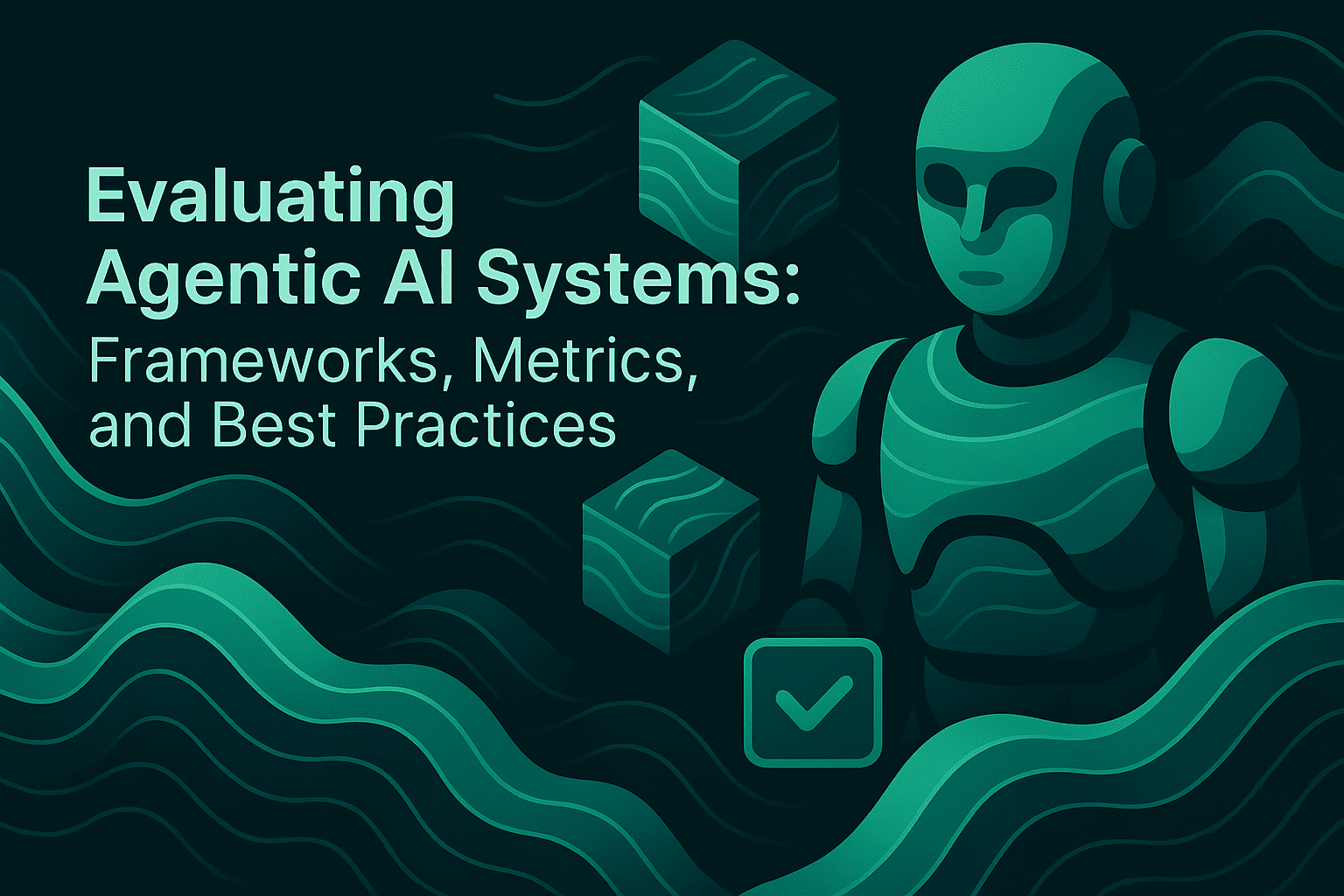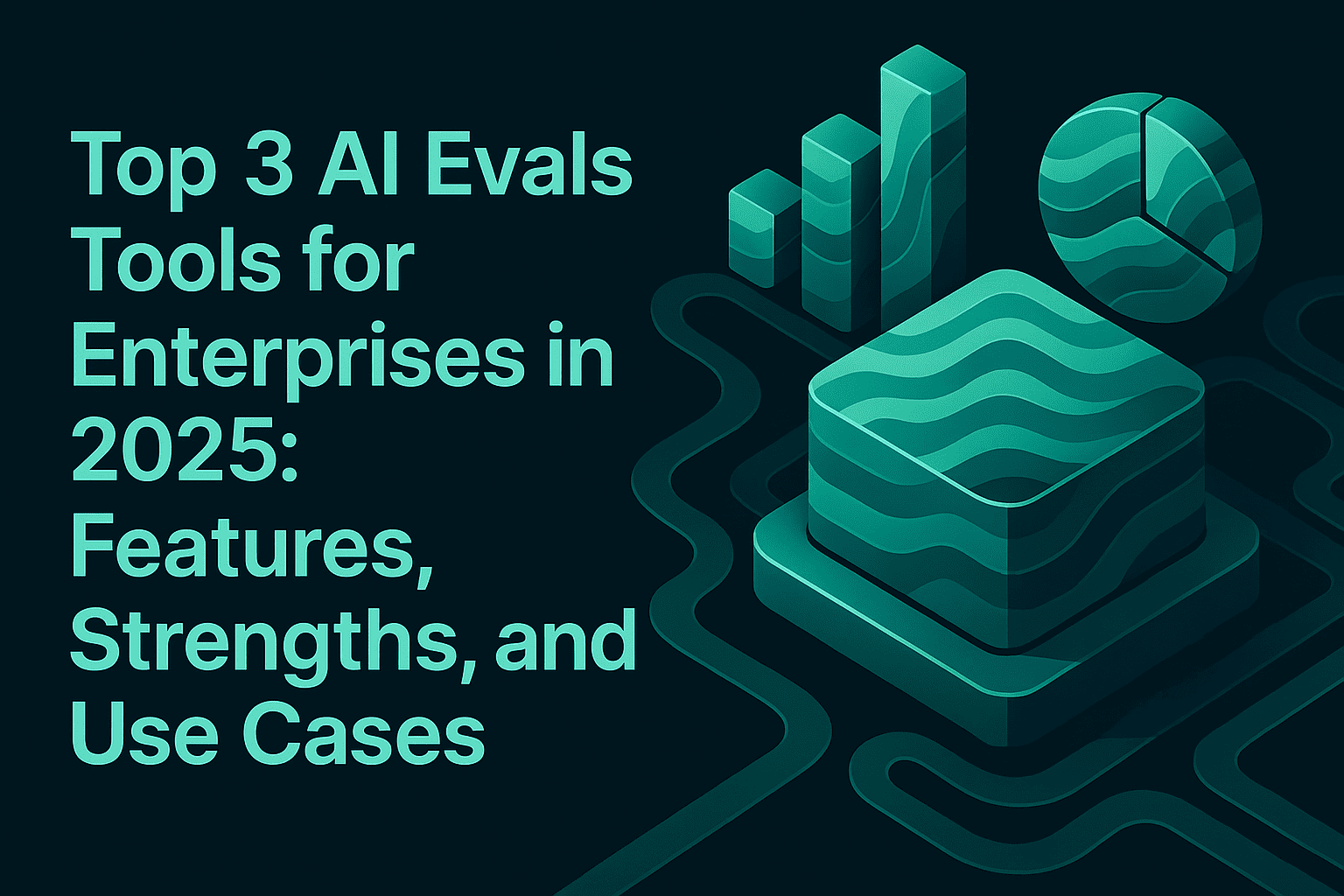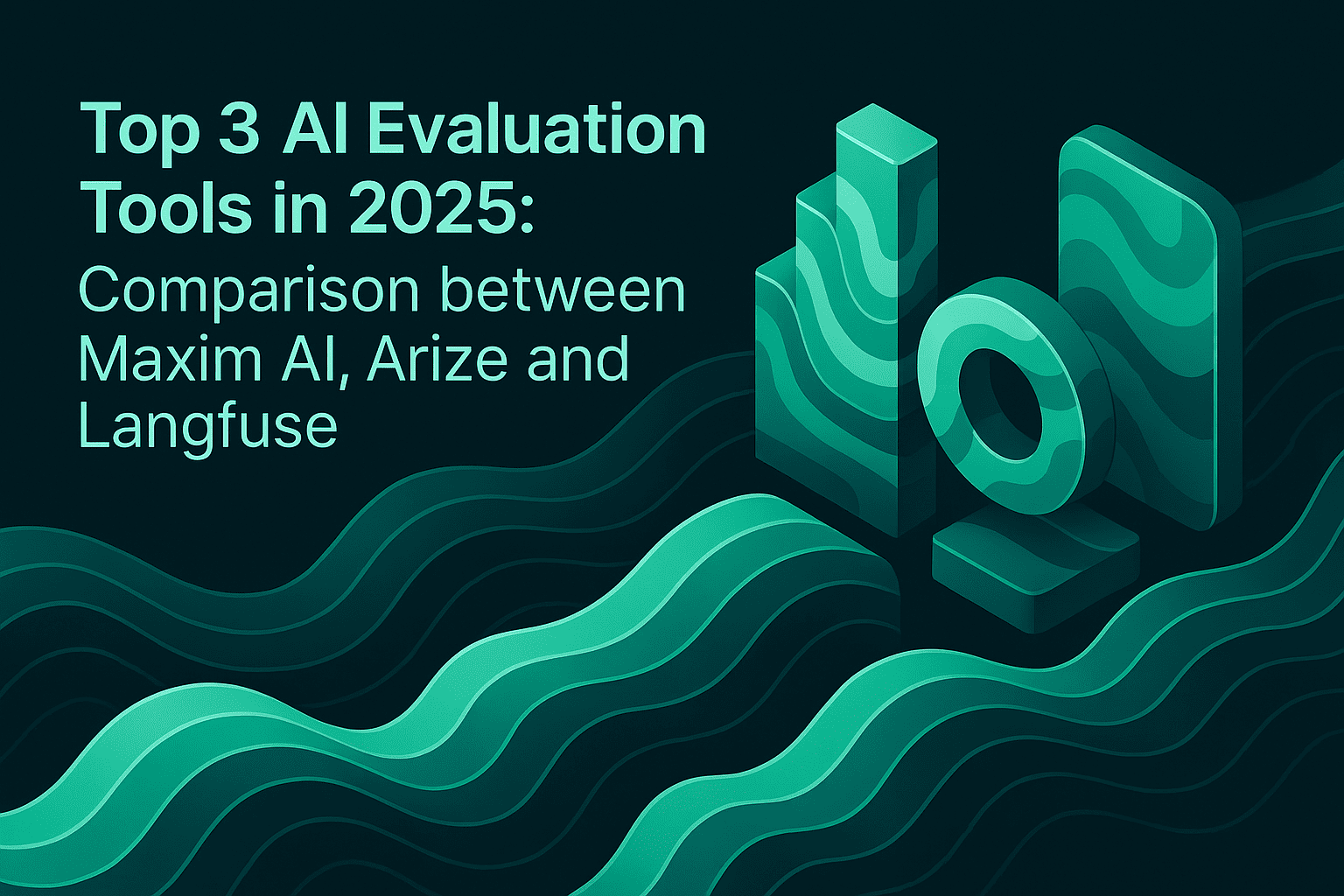Complete Guide to RAG Evaluation: Metrics, Methods, and Best Practices for 2025

Retrieval-Augmented Generation (RAG) systems have become foundational architecture for enterprise AI applications, enabling large language models to access external knowledge sources and provide grounded, context-aware responses. However, evaluating RAG performance presents unique challenges that differ significantly from traditional language model evaluation. Research from Stanford's AI Lab indicates that poorly evaluated RAG systems can produce hallucinations in up to 40% of responses despite accessing correct information, making systematic evaluation critical for production deployments.
This comprehensive guide examines the key metrics, methodologies, and tools for RAG evaluation, with detailed coverage of how Maxim AI's evaluation platform enables teams to measure and improve RAG system quality systematically.
Understanding RAG Evaluation Challenges
RAG systems introduce complexity that traditional language model evaluation frameworks cannot adequately address. Unlike standalone LLMs, RAG architectures involve multiple components—retrieval mechanisms, knowledge bases, ranking algorithms, and generation models—each contributing to overall system quality.
Multi-Component Performance Dependencies
RAG system quality depends on the interaction between retrieval and generation components. A study published in the Journal of Machine Learning Research demonstrates that retrieval accuracy alone explains only 60% of variance in end-to-end RAG quality, with generation conditioning and context utilization accounting for the remainder.
This interdependency means that evaluating components in isolation provides incomplete quality assessment. Teams must measure both retrieval performance and how effectively the generation model utilizes retrieved context to produce accurate responses.
Context Utilization and Attribution
Retrieved documents may contain relevant information that the generation model fails to utilize properly, or the model may ignore retrieved context entirely and rely on parametric knowledge instead. According to research from Google DeepMind, RAG systems frequently exhibit "context neglect," generating responses based on model priors rather than retrieved information even when correct context is provided.
Effective RAG evaluation must assess whether models appropriately ground responses in retrieved context and correctly attribute information to source documents.
Retrieval Quality vs. Answer Quality
High retrieval precision does not guarantee high-quality answers. Retrieved documents may contain correct information presented ambiguously, require synthesis across multiple sources, or include contradictory claims that models must reconcile.
The BEIR benchmark demonstrates significant variation between retrieval metrics and downstream task performance across different domains, highlighting the need for end-to-end evaluation that measures actual answer quality rather than intermediate retrieval metrics alone.
Essential RAG Evaluation Metrics
Comprehensive RAG evaluation requires metrics spanning retrieval quality, context utilization, answer accuracy, and system behavior. Organizations should implement evaluation frameworks that capture performance across these dimensions.
Retrieval Metrics
Precision and Recall: Traditional information retrieval metrics measure the proportion of retrieved documents that are relevant (precision) and the proportion of relevant documents successfully retrieved (recall). These metrics provide baseline retrieval performance assessment but require labeled relevance judgments.
Mean Reciprocal Rank (MRR): MRR evaluates the ranking quality of retrieved results by measuring the reciprocal rank of the first relevant document. This metric is particularly useful for RAG systems where only top-ranked results influence generation, as demonstrated in Microsoft Research's evaluation framework.
Normalized Discounted Cumulative Gain (NDCG): NDCG accounts for both relevance and ranking position, with higher weights assigned to documents appearing earlier in retrieved results. Research indicates NDCG correlates more strongly with end-to-end RAG quality than binary relevance metrics.
Context Utilization Metrics
Context Precision: Measures the proportion of retrieved context chunks that are actually utilized in the generated answer. Low context precision indicates retrieval is returning excessive irrelevant information, potentially confusing the generation model.
Context Recall: Evaluates whether all necessary information required to answer the query correctly appears in the retrieved context. Low context recall indicates retrieval gaps that prevent accurate answer generation.
Faithfulness: Assesses whether generated answers remain faithful to retrieved context without introducing unsupported claims. The RAGAs framework provides automated faithfulness evaluation using LLM-as-a-judge approaches that compare generated statements against source documents.
Answer Quality Metrics
Correctness: Measures factual accuracy of generated answers against ground truth references. Correctness evaluation can use exact match, semantic similarity, or LLM-based scoring depending on answer format and domain.
Completeness: Evaluates whether answers address all aspects of the query comprehensively. Incomplete answers may be technically correct but fail to provide sufficient information for user needs.
Conciseness: Measures answer brevity relative to information content. Verbose answers that include excessive retrieved context without synthesis indicate poor generation conditioning.
Attribution and Grounding Metrics
Citation Accuracy: For RAG systems that provide source citations, this metric evaluates whether cited sources actually support the attributed claims. According to research from Allen Institute for AI, citation accuracy in RAG systems averages only 65-70% without explicit attribution training.
Grounding Score: Measures the degree to which generated content derives from retrieved documents versus model parametric knowledge. High grounding scores indicate proper RAG behavior where generation relies on external knowledge rather than memorized information.
Evaluating RAG Systems with Maxim AI
Maxim AI's evaluation platform provides comprehensive infrastructure for RAG evaluation, enabling teams to measure retrieval quality, context utilization, and answer accuracy through unified workflows.
Pre-Production RAG Testing with Experimentation
Maxim's Playground++ enables rapid iteration on RAG system components before production deployment. Teams can test different retrieval strategies, embedding models, and generation prompts while comparing performance across configurations.
The experimentation environment supports connecting to vector databases, knowledge bases, and RAG pipelines directly, enabling realistic testing against production data sources. Teams can compare output quality, latency, and cost across various combinations of retrievers and generators side-by-side, simplifying optimization decisions.
Key capabilities include:
- Testing retrieval quality with different embedding models and similarity thresholds
- Evaluating how prompt engineering affects context utilization
- Comparing RAG performance across different LLM providers
- Measuring response latency and token costs for different configurations
Comprehensive RAG Evaluation Framework
Maxim provides a unified evaluation framework that combines automated and human evaluation methods for assessing RAG systems. The platform includes an evaluator store with off-the-shelf evaluators specifically designed for RAG evaluation alongside support for custom evaluators tailored to domain-specific requirements.
Automated RAG Evaluators: Maxim offers pre-built evaluators that measure critical RAG metrics including:
- Retrieval relevance scoring using semantic similarity
- Context utilization assessment through faithfulness checks
- Answer correctness evaluation using LLM-as-a-judge approaches
- Citation accuracy verification
- Hallucination detection for unsupported claims
These evaluators can be configured at session, trace, or span level, enabling granular assessment of multi-step RAG workflows. For complex RAG systems that perform multiple retrieval passes or synthesis operations, span-level evaluation provides detailed visibility into which components contribute to quality issues.
Human Evaluation Workflows: While automated metrics provide scalability, human evaluation remains essential for nuanced quality assessment. Maxim's human evaluation capabilities enable teams to:
- Collect expert judgments on answer quality systematically
- Validate automated evaluation scores through sampling
- Identify edge cases and failure modes that automated evaluators miss
- Incorporate domain expertise into RAG system assessment
Human evaluation data collected through Maxim feeds directly into model improvement workflows, enabling continuous quality enhancement based on expert feedback.
RAG Simulation and Scenario Testing
Maxim's simulation capabilities allow teams to test RAG systems across hundreds of scenarios before production deployment. AI-powered simulation generates diverse user queries spanning different topics, question types, and difficulty levels, enabling comprehensive coverage of potential user interactions.
Simulation testing is particularly valuable for RAG systems because it reveals how systems perform across the full distribution of potential queries rather than just curated test sets. Teams can:
- Generate queries that test different aspects of the knowledge base
- Simulate edge cases where retrieval may fail or return ambiguous results
- Test system behavior with queries requiring synthesis across multiple documents
- Evaluate performance on queries outside the knowledge base scope
Simulation runs can be configured with custom evaluation criteria, measuring both component-level metrics (retrieval quality) and end-to-end performance (answer correctness). Teams visualize evaluation results across large test suites, identifying systematic weaknesses and prioritizing optimization efforts.
Production RAG Monitoring and Observability
Maxim's observability suite enables continuous monitoring of RAG systems in production. The platform provides real-time rag tracing and distributed tracing across multi-component RAG workflows, capturing retrieval results, generation inputs, and final outputs for comprehensive analysis.
Key observability features for RAG systems include:
Automated Quality Checks: Run periodic evaluations on production traffic to detect quality regressions. Teams can configure automated evaluators that measure retrieval relevance, faithfulness, and answer correctness continuously, triggering alerts when metrics degrade below defined thresholds.
RAG Observability: Track retrieval performance metrics including documents retrieved per query, retrieval latency, and embedding similarity scores. This visibility enables teams to identify when retrieval quality degrades due to knowledge base updates, query distribution shifts, or infrastructure issues.
Failure Pattern Detection: Maxim's analysis tools help teams identify systematic failure patterns in production RAG systems. Common failure modes include:
- Queries where retrieval returns no relevant results
- Cases where the generation model ignores retrieved context
- Situations where contradictory information across documents causes inconsistent answers
- Knowledge base gaps for frequently asked questions
Dataset Curation from Production: Maxim's Data Engine enables teams to curate evaluation and fine-tuning datasets directly from production logs. Teams can filter production queries by evaluation scores, user feedback, or specific failure patterns, systematically building datasets that capture real-world edge cases and quality issues.
This capability is particularly valuable for RAG systems where initial test datasets may not represent the full distribution of production queries. Continuous dataset curation ensures evaluation remains aligned with actual usage patterns.
End-to-End RAG Evaluation Workflow
Maxim supports complete RAG evaluation workflows from experimentation through production:
- Experimentation Phase: Test retrieval strategies and generation approaches in Playground++, comparing performance across configurations
- Simulation Phase: Run AI-powered simulations across diverse scenarios, identifying failure modes before deployment
- Evaluation Phase: Measure quality systematically using automated and human evaluators on comprehensive test suites
- Deployment Phase: Deploy RAG systems with confidence based on validated evaluation results
- Monitoring Phase: Track production performance continuously, detecting regressions and collecting data for improvement
This integrated workflow reduces the time from RAG system development to reliable production deployment, with evaluation data flowing seamlessly across stages.
Best Practices for RAG Evaluation
Implementing effective RAG evaluation requires methodological rigor and systematic approaches that extend beyond ad-hoc testing.
Establish Comprehensive Test Datasets
Build evaluation datasets that represent the full distribution of expected queries, including:
- Common questions with clear answers in the knowledge base
- Complex queries requiring synthesis across multiple documents
- Edge cases where information may be ambiguous or contradictory
- Questions outside knowledge base scope to test graceful failure
- Queries with multiple valid interpretations requiring clarification
Research from Meta AI demonstrates that evaluation datasets skewed toward simple queries significantly overestimate production RAG quality, with accuracy dropping 25-30% on realistic query distributions.
Evaluate Components and End-to-End Performance
Assess both individual component quality and integrated system performance. Component-level evaluation helps isolate issues (retrieval vs. generation), while end-to-end evaluation measures actual user-facing quality.
For retrieval, measure relevance of retrieved documents independently using labeled relevance judgments. For generation, evaluate answer quality assuming perfect retrieval by providing ground-truth context. Then measure integrated performance where retrieval and generation interact naturally.
Incorporate Domain Expertise
Automated metrics provide scalability but cannot capture domain-specific quality requirements. Include domain experts in evaluation workflows to:
- Validate that answers meet accuracy standards for the specific application
- Identify subtle errors that automated evaluators miss
- Define success criteria that align with business objectives
- Provide examples of good and poor responses for evaluator calibration
Monitor Evaluation Metric Correlations
Track correlations between different evaluation metrics to understand which measurements best predict user-facing quality. Research indicates that metric correlations vary significantly across domains, with retrieval metrics correlating strongly with answer quality in some applications but weakly in others.
Regularly validate that evaluation metrics align with user feedback and business outcomes, adjusting measurement approaches when misalignment occurs.
Implement Continuous Evaluation
RAG system quality degrades over time as knowledge bases evolve, query distributions shift, and user expectations change. Implement continuous evaluation that:
- Runs automated evaluators on production traffic regularly
- Monitors evaluation metric trends to detect gradual degradation
- Alerts teams when quality drops below defined thresholds
- Triggers re-evaluation when system components or knowledge bases update
Test Across Multiple Dimensions
Comprehensive RAG evaluation requires assessing multiple quality dimensions simultaneously:
- Accuracy: Are answers factually correct?
- Completeness: Do answers address all aspects of the query?
- Conciseness: Are answers appropriately brief?
- Attribution: Are sources cited correctly?
- Latency: Do responses arrive within acceptable timeframes?
- Cost: Is the system cost-effective for the quality level delivered?
Optimizing for single metrics often degrades other dimensions. For example, increasing the number of retrieved documents may improve completeness but hurt conciseness and latency.
Common RAG Evaluation Pitfalls
Teams frequently encounter challenges when implementing RAG evaluation frameworks. Understanding these pitfalls enables proactive mitigation.
Over-Reliance on Retrieval Metrics
Teams often focus evaluation exclusively on retrieval quality, assuming that good retrieval ensures good answers. However, generation quality and context utilization significantly impact end-to-end performance independently of retrieval accuracy.
Studies show that improving retrieval recall from 80% to 95% may only improve answer quality by 5-10% if the generation model poorly utilizes retrieved context. Balanced evaluation across retrieval and generation provides more actionable insights.
Insufficient Test Dataset Coverage
Evaluation datasets that focus primarily on queries with clear, straightforward answers fail to stress-test RAG systems adequately. Production environments include ambiguous queries, questions with no clear answer, and requests outside knowledge base scope.
Building datasets that deliberately include challenging cases reveals system weaknesses that homogeneous test sets miss.
Ignoring Context Window Limitations
RAG systems must fit retrieved context within model context windows alongside instructions and conversation history. Teams sometimes evaluate retrieval quality assuming unlimited context availability, failing to account for truncation or prioritization required in practice.
Evaluation should reflect realistic context window constraints, measuring performance when retrieval must be truncated or filtered to fit within limits.
Neglecting Failure Mode Analysis
Aggregate metrics like average accuracy or precision obscure systematic failure patterns. A RAG system with 85% average accuracy may perform well on simple queries but fail consistently on specific question types or topics.
Detailed failure analysis that segments performance by query characteristics, topics, or user types provides actionable insights for targeted improvements.
Conclusion
Effective RAG evaluation requires comprehensive frameworks that assess retrieval quality, context utilization, and answer accuracy across diverse scenarios. As RAG systems become critical infrastructure for enterprise AI applications, systematic evaluation becomes essential for ensuring reliability and continuous improvement.
Maxim AI provides end-to-end RAG evaluation capabilities that enable teams to measure and optimize RAG performance across the complete development lifecycle—from experimentation through production monitoring. The platform's unified approach to simulation, evaluation, and observability reduces time-to-production for RAG systems while ensuring quality standards are met consistently.
Organizations building RAG applications benefit from Maxim's comprehensive evaluation framework, flexible evaluators configurable at multiple granularity levels, and seamless data curation workflows that continuously improve evaluation datasets based on production learnings.
Get started with Maxim AI to implement robust RAG evaluation and ship reliable AI applications more than 5x faster.


